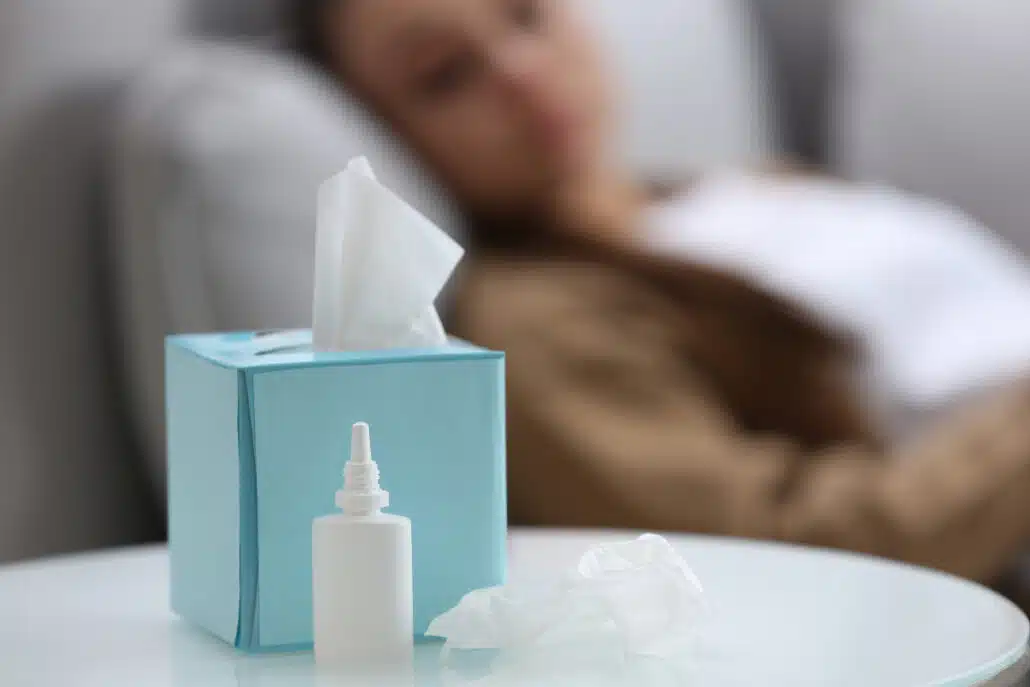Managing Common Post-Rhinoplasty Symptoms: Runny Nose and Nasal Discomfort

Have you ever considered whether the complications of rhinoplasty surgery could be adequately treated at home? Managing post-operative symptoms like a runny nose, pain, and swelling can be overwhelming. Let’s get into the nitty-gritty of post-rhinoplasty care, detailing what to expect and how to go through recovery with ease, including addressing issues following surgery.
Understanding Rhinoplasty and Its Effects
The purpose of rhinoplasty, or “nose job,” is to alter the nose’s appearance or function using surgical means. Subtle rhinoplasty procedures may involve reshaping the nasal cartilage, skin, or bone. Nasal swelling is a typical side effect of surgery that patients often face. It’s transient and needs to be managed carefully. Potential side effects include redness, swelling, pain, and a runny nose.
Though these are expected outcomes of rhinoplasty surgery, understanding these side effects will enable patients to manage them better, ensuring a smoother healing process. Navigating the post-surgical phase without unnecessary patient concern or suffering depends on this basic information. We will explore each of these consequences in more detail in the next sections and walk you through post-rhinoplasty management of them.
Runny Nose After A Nose Job

Causes of a Runny Nose After Rhinoplasty
A runny nose is a common symptom after a nose surgery. It results from damage done to the mucosa during the operation as well as from nasal swelling and passage irritability. Sometimes individuals also show symptoms of a minor infection or nasal polyps, which might lead to this disorder.
A cold following a rhinoplasty procedure can also lead to a runny nose. Most of the time, this is because the treatment made the nasal passages weaker, making it easier to get a cold. Also, many nasal allergies can make your nose run because they can hurt and inflame the sensitive tissue in your nose. Because of this, it is important to know about any allergies you may have so that you can avoid them and lessen any pain they might cause.
Treating the Runny Nose
While a runny nose can be quite uncomfortable and annoying, it is not something to be overly concerned about if treated correctly. There are several treatments available to help relieve the symptoms of a runny nose after rhinoplasty.
- Do not blow your nose: Let the nasal drip occur naturally and wipe it with a tissue.
- Use saline nasal spray: Use a specially designed saltwater solution to flush out any irritants and allergens from the nasal passages, reducing inflammation and providing relief from irritation. It also keeps the passages moist. In addition, you may also use an antihistamine nasal spray to reduce allergic symptoms.
- Use a neti pot: This can regularly help to reduce nasal congestion and is an effective way to flush out any buildup of mucus or allergens in the nose.
- Take medication: If your runny nose is caused by an infection, you must follow your doctor’s instructions and take a course of antibiotics. If you have allergies, you may also need to take anti-allergy drugs.
- Tips for Preventing a Runny Nose After RhinoplastyIt is essential to follow the care instructions given by your doctor before and after rhinoplasty surgery. These instructions will help you to reduce the risk of complications.
- Keep the area clean: Cleaning the nose regularly with a gentle, non-irritating cleanser can help prevent any bacterial or fungal infections that may lead to a runny nose.
- Be aware of your allergies: Identifying any allergies or sensitivities that you may have is important to avoid any potential triggers that may cause nasal irritation or inflammation.
- Avoid environmental irritants: Avoid exposure to environmental irritants such as smoke, dust, or pollen which can aggravate the condition.
- Stay hydrated: Drink plenty of fluids as they help keep your nasal passages moist.
- Consult your surgeon: If you experience any symptoms that are too severe or persistent, it is best to talk to your surgeon as they may recommend a course of medication.
Secure Your Safe Treatment Experience with Dr. Daniel G. Becker.
Join our satisfied clients who’ve experienced safe, effective treatments.
Nasal Discomfort and Pain Post-Rhinoplasty
Causes of Nasal Discomfort and Pain After Rhinoplasty
Common post-rhinoplasty symptoms include nasal irritation and soreness. This is due to the sensitive nature of the nose and the potential for considerable harm to the delicate tissues in the area during surgery. In addition, many patients develop swelling and inflammation in their nasal passages following surgery, which can be uncomfortable and even painful. In some circumstances, heavy bleeding can be a problem.
Treating Nasal Discomfort and Pain
Treating nasal discomfort and pain after rhinoplasty can be done in several ways:
- Use ice packs: Ice packs can help reduce swelling and discomfort after rhinoplasty. Apply them for 20 minutes at a time, several times a day. Follow your doctor’s instructions carefully, as using ice packs too much can do more harm than good. Cold compresses or soaking your face in cold water can also help.
- Take Pain Medication: Use ibuprofen or acetaminophen to reduce inflammation and level of discomfort after rhinoplasty. Follow your doctor’s instructions and only take the medication as directed. Do not exceed the recommended dosage or use other pain relievers without consulting a doctor. Avoid aspirin as it can cause excessive bleeding.
Tips for Preventing Nasal Discomfort and Pain After Rhinoplasty
After rhinoplasty, it is important to follow your doctor’s instructions on how to take care of the nose:
- Have plenty of rest: Have plenty of rest and follow the instructions provided by your surgeon regarding when to resume normal activities. Get plenty of sleep as this helps the body to heal faster.
- Be careful with your diet: After rhinoplasty surgery, be careful with your diet to prevent inflammation and discomfort in the nasal passages. Avoid spicy foods as they can irritate the delicate tissues in the nose and worsen symptoms. Also, stay away from foods high in salt, sugar, and alcohol as they can cause fluid retention and worsened inflammation.
- Follow your doctor’s instructions: Follow your doctor’s instructions after rhinoplasty. Take medications as directed and avoid strenuous activities. Keep up with follow-up appointments for proper healing.
- Avoid strenuous activities: After rhinoplasty, do not engage in intense activities or sports. Avoid any activity that could harm or strain the nose during recovery time. This includes contact sports, heavy lifting, running, or any high-intensity exercises. It is recommended to limit strenuous activity for at least 3-4 weeks to allow the nose to fully heal.
- Keep your Head Elevated: After rhinoplasty, it’s important to keep your head elevated. This helps reduce swelling, discomfort, and bleeding in the nasal passages. Keep your head raised above the heart by propping up pillows when sleeping or sitting. Do this for at least the first few days after surgery.
When to See a Doctor for Post-Rhinoplasty Symptoms
If you encounter any complications following rhinoplasty, including as significant discomfort, infection, or lingering swelling, you should seek medical attention. Other symptoms may indicate functional difficulties requiring revision rhinoplasty. In general, any prolonged discomfort or change in your breathing should be investigated by a medical practitioner. Consultation with your surgeon is the most effective way to ensure optimal treatment and recovery after rhinoplasty.
Consult with a Rhinoplasty Specialist
If you are considering rhinoplasty and have concerns about the recovery process, it is important to consult with an experienced plastic surgeon. An experienced plastic surgeon like Dr. Becker can discuss the risks and benefits associated with rhinoplasty as well as provide information on the latest surgical techniques for both functional and cosmetic purposes. He can also explain the potential side effects and necessary post-operative care to ensure a successful recovery. Schedule a consultation today!